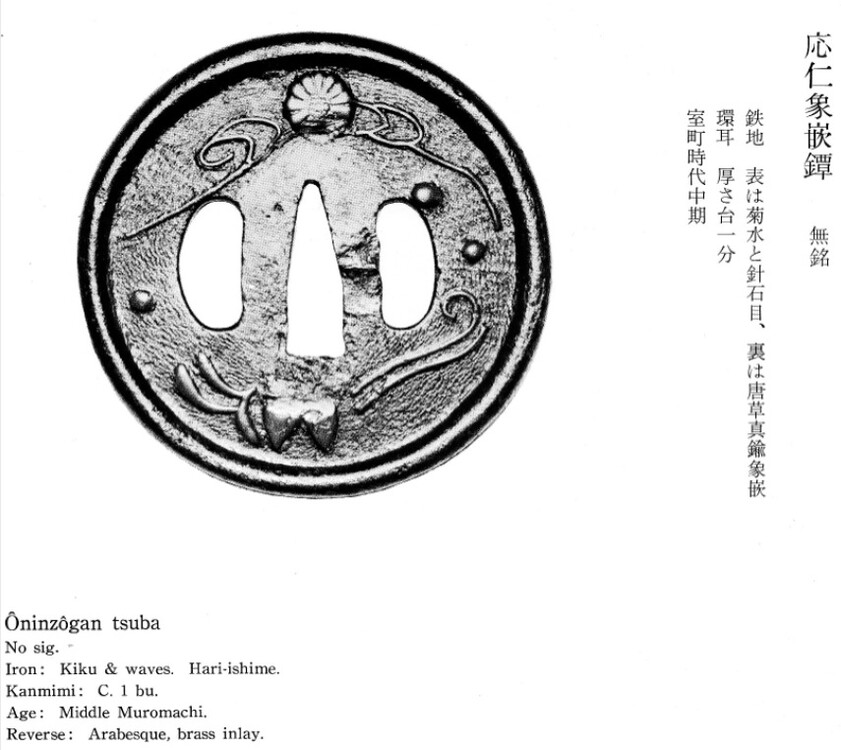-
Posts
779 -
Joined
-
Days Won
1
Content Type
Profiles
Forums
Events
Store
Downloads
Gallery
Everything posted by reinhard
-
By saying "nice" I didn't mean to reveal my personal preferences. It just meant: "Possibly genuine" which is meaning a lot nowadays and on a public forum like this. My dear Hobbit friends: Put your Western preferences aside for a moment and try to anticipate the taste of samurai during middle to late Muromachi period. Here are some examples. BTW Henry, you are probably associating Onin-zogan with ten-zogan ("nail-head zogan"), but there is more to it. reinhard
-
Joe, Text says: kuni fumei ("origin unknown"), teien-zu ("garden design"), followed by specifications,measurements and saying it's mumei. - Despite of some acid-crazed commentaries, this looks like some nice tsuba between O-Nin and Heian-Jo style to me. reinhard edit: Henry and Guido were ahead of me. Sorry for repeating.
-
What makes them think so? Ko-Nyudo KUNIMITSU's work is very difficult to track for he left hardly any signed works. Actually Uda KUNIMITSU is close to a mere myth. Even the experts of N.B.T.H.K. prefer to speak of Ko-Uda instead of Uda KUNIMITSU. Your friends must have good reasons to be so precise in their statements. Let us hear. reinhard
-
Andrey, Your latest pics are probably posted in order to show strong tekkotsu, especially in the rim. Unfortunately these kind of "bones" are not necessarily a hint for old age or quality. Although tekkotsu are a important factor to determine a tsuba's quality, this kind of mixed steel steel was in use during late Edo-period and later, leading to many confusions. Proportions, weight, asymmetry and surface of this tsuba leave me with no other conclusion than before. reinhard
-

Shrine Blade Plaque Translation please help?
reinhard replied to ludvig75's topic in Translation Assistance
It looks like a very cheap bait. You better go public with the full sword now. reinhard -
These measurements are pointing towards a Katchushi-style tsuba being reminiscent of older examples and the "good old days". Taking into consideration steel quality, patina, surface finish and other features on the basis of your pics, this tsuba was probably made during Bakumatsu. It aires the revivalist spirit of these days. Lack of craftsmanship combined with a tendency to exaggerate is typical. I can't help you with the signature, I'm afraid. reinhard
-
"Nice bo-hi" (whatever that's supposed to mean here) and "nice shine" are of less to no importance when buying a genuine NihonTo. You better think about it again. Is that what you really want? reinhard
-
Andrey, Could you provide us with some measures, if you please? Diameters (vertical/horizontal) and thickness of rim and especially of the plate might help. Thank you. reinhard
-
Ford, I hardly ever "condemn" anything, certainly not sword-fittings; but seriously: I do not relate this kind of design nor this kind of workmanship to Edo-period workmanship for several reasons. Design: Using the imperial Kiku-mon for design was (and is) a delicate thing to do. During the days of the samurai it used to be placed very carefully and was executed by craftsmen of superior skills only. Remember the swords attributed to emperor Gotoba-In himself. The Kiku-mon was added on the habaki-moto area so it would be protected and not be touched by fingers. - Rules were loosened later, but a minimal respect always remained. The design of this particular Fuchi (and Kashira) lacks this respect completely. Kiku-mon, cleanly cut in half, looks more likely to be a product of post-Edo nationalism and is reflecting the primitive attitude towards heritage during these times. Furthermore proportions are not right. Especially Fuchi is too big for this kind of Koshirae. Workmanship: The carvings are shaky and clumsy. They are far from late Edo-period standards. You, a trained craftsman, should have no problem seeing this. reinhard
-
There is a general thing to say about ShowaTo and I don't mean the militaria stuff. During early Showa era many people wanted to have a "samurai sword" but only few could afford a genuine one. Therefore older parts, usually of lesser quality, were assembled with newly made pieces. The new parts were usually of poor to lousy quality. In this particular case the Kashira seems to be of better quality than the Fuchi whose design and carving is a shame. Although I'm not interested in GendaiTo and "Dai Nippon"-nostalgia from this period at all, it is hard to avoid them in the West. Problem is: Many of these ShowaTo works, seventy to ninety years old by now, left Japan and were/are sold for the real thing now. Coming across a sword with Tsuka wrapped in blue or blue-green Ito, decorated with fittings of strongly varying quality together with extensive use of Kiku-Mon for decoration should ring a bell. The chances of seeing a ShowaTo are pretty high then. I owned one of these assemblies for a while when I was still very green and I had time to study it in detail. I got rid of it later, but these kind of Koshirae pop up quite frequently in the West. I've seen one of similar quality recently when I was called by an auction-house to see a late Seki-blade. It is quite difficult to find material to show you what I mean. Maybe this pic will give you an idea. The link to the site is just for confirmation, although some of the militaria guys will probably use it for their own purposes. reinhard http://g55-amg-long-gelandewagen.web.in ... on_1x.html
-
I subscribe to this. The "SA"-mei on the sashi omote (!) is of lesser or no importance here, but the blade might be worthwile. Have it checked by a reliable pro. reinhard
-
Just one more thing: Always start with the blade, never with its mei, unless there's no other way. reinhard
-
-
It takes another calibre to confuse me, but maybe you confused Joe and the many people watching from outside. reinhard
-
-
A general advice for all newbies on NMB would be: Don't go public with your e-mail address from the very beginning. Allowing easy contact with perfect strangers makes you an easy prey. Once you're familiar with the darker side of the sword-world you can still lift your visor and laugh at the usual suspects. reinhard
-
Could you explain on this, please? Telling from the pictures, it looks like perfect utsuri to me. What makes you think so? reinhard
-

Help with a tang traslation please .
reinhard replied to dmgriff59's topic in Translation Assistance
It is not a date. It is a writing in hiragana, starting "sa.......". reinhard -
Congratulations Curran, This kake seems to be a very rare and special object. Take good care of it (and of yourself). reinhard
-
This tsuka (including Fuchi and Kashira) was made for a Showa-To during the 1920-1930ies. No need to search for any particular school, for there weren't any. Workmanship is very poor BTW. reinhard
-
I wonder about this particular mistake Moriyama-san presented, for "shu" is including the meaning of "kuni"(province) and there are no mei "Bishu (no) Kuni" at all as far as I know. This should ring a bell in any case, but then: The mei is quite deteriorated, the blade is a poor shadow of its former self and the guy writing the origami was eventually left to be the last man to turn off the lights. Who knows. Not much harm was done in this particular case. reinhard
-
Hi Curran, After a quick look the column top right is a date: Ho-Reki yon'nen (Horeki era 4th year) equivalent of 1754 AD. The column on the left continues: "... a day in sixth month" and probably ends with the name of the maker, who created this (kake), but this is beyond me without doing any further research. This might be of some help to you anyway. reinhard
-














